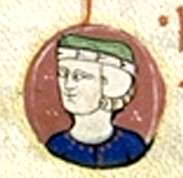Peter I, Count of Alençon
Peter I of Alençon (born 1251 in Atlit, Kingdom of Jerusalem - d. 6 April 1284 in Reggio Calabria, Italy) was the son of Louis IX of France and Margaret of Provence. He became Count of Alençon in 1269 and in 1284, Count of Blois and Chartres, and Seigneur de Guise in 1272 and 1284. He was also Count of Perche.[1]

Life
Peter was born at Atlit, Kingdom of Jerusalem,[2] while his father led the Seventh Crusade. Back in France, he lived in Paris until 1269 when his father gave him in appanage the County of Alençon.[3] He accompanied his father to Tunis during Eighth Crusade (1270), but this expedition was a fiasco, because of the dysentery epidemic that decimated the army of crusaders. His father and his brother Jean Tristan succumbed to the disease.
Following the death of his father in 1270, Louis XI, Peter's brother Philip became king of France.[4] One of Philip III's first acts was to name Peter as regent in the event of his death.[4]
In December 1282, during the Sicilian Vespers, Peter marched his army to Naples to assist his uncle Charles I of Naples, stopping at Reggio Calabria.[5] By January 1283, he was at Catona, a suburb of Reggio, when he was attacked by Aragonese mercenaries and killed.[5] His body was taken to Paris, where he was buried, with his heart interred at the now-demolished church of the Couvent des Jacobins.[6] After his death without surviving son, his portion of Alençon returned to the Crown.[7] His widow did not remarry and sold Chartres in 1286 to King Philip IV the Fair.[8] On her death Guise and Blois passed to her cousin Hugh of the House of Châtillon.
Marriage
Peter married in 1272 Joan of Châtillon,[9] which brought him the lands Blois, Chartres and Guise. They had:
- Louis (1276-77)
- Philip (1278–79)

Ancestry
| Ancestors of Peter I, Count of Alençon | ||||||||||||||||||||||||||||||||||||||||||||||||||||||||||||||||||||||||||||||||||||||||||||||||||||||||||||||||||||||||||||||||||||||||||||||||||||||||||||||||||||||||||||||||||||||||||||||||||||||||||||||||||||||||||||||||||||||||||||||||||||||||||||||||||||||||||||||||||||||||||||||||||||||||||||||||||||||||||||||||||||||||||||||||||||||||||||||||||||||||||||||||||||||||||||||||||||||||||||||||||||||||||||||||||||||||||||||||||||||||||||||||||||||||||||||||||||||||||||||||||||||||||||||||||||||||||||||||||||||||||||||||||||||||||||||||||||||||||||||||||||||||||||||||||||||||||||||||
|---|---|---|---|---|---|---|---|---|---|---|---|---|---|---|---|---|---|---|---|---|---|---|---|---|---|---|---|---|---|---|---|---|---|---|---|---|---|---|---|---|---|---|---|---|---|---|---|---|---|---|---|---|---|---|---|---|---|---|---|---|---|---|---|---|---|---|---|---|---|---|---|---|---|---|---|---|---|---|---|---|---|---|---|---|---|---|---|---|---|---|---|---|---|---|---|---|---|---|---|---|---|---|---|---|---|---|---|---|---|---|---|---|---|---|---|---|---|---|---|---|---|---|---|---|---|---|---|---|---|---|---|---|---|---|---|---|---|---|---|---|---|---|---|---|---|---|---|---|---|---|---|---|---|---|---|---|---|---|---|---|---|---|---|---|---|---|---|---|---|---|---|---|---|---|---|---|---|---|---|---|---|---|---|---|---|---|---|---|---|---|---|---|---|---|---|---|---|---|---|---|---|---|---|---|---|---|---|---|---|---|---|---|---|---|---|---|---|---|---|---|---|---|---|---|---|---|---|---|---|---|---|---|---|---|---|---|---|---|---|---|---|---|---|---|---|---|---|---|---|---|---|---|---|---|---|---|---|---|---|---|---|---|---|---|---|---|---|---|---|---|---|---|---|---|---|---|---|---|---|---|---|---|---|---|---|---|---|---|---|---|---|---|---|---|---|---|---|---|---|---|---|---|---|---|---|---|---|---|---|---|---|---|---|---|---|---|---|---|---|---|---|---|---|---|---|---|---|---|---|---|---|---|---|---|---|---|---|---|---|---|---|---|---|---|---|---|---|---|---|---|---|---|---|---|---|---|---|---|---|---|---|---|---|---|---|---|---|---|---|---|---|---|---|---|---|---|---|---|---|---|---|---|---|---|---|---|---|---|---|---|---|---|---|---|---|---|---|---|---|---|---|---|---|---|---|---|---|---|---|---|---|---|---|---|---|---|---|---|---|---|---|---|---|---|---|---|---|---|---|---|---|---|---|---|---|---|---|---|---|---|---|---|---|---|---|---|---|---|---|---|---|---|---|---|---|---|---|---|---|---|---|---|---|---|---|---|---|---|---|---|---|---|---|---|---|---|---|---|---|---|---|---|---|---|---|---|---|---|---|---|---|---|---|---|---|---|---|---|---|---|---|---|---|---|---|---|---|---|---|---|---|---|---|---|---|---|---|---|---|---|---|---|---|---|---|---|---|---|---|---|---|---|---|---|---|---|---|---|---|---|---|---|---|---|---|---|---|---|---|---|---|---|---|---|---|---|---|---|---|---|---|---|---|---|---|---|---|---|---|---|---|---|---|---|---|---|---|---|---|---|---|---|---|---|---|---|---|---|---|---|---|---|
| ||||||||||||||||||||||||||||||||||||||||||||||||||||||||||||||||||||||||||||||||||||||||||||||||||||||||||||||||||||||||||||||||||||||||||||||||||||||||||||||||||||||||||||||||||||||||||||||||||||||||||||||||||||||||||||||||||||||||||||||||||||||||||||||||||||||||||||||||||||||||||||||||||||||||||||||||||||||||||||||||||||||||||||||||||||||||||||||||||||||||||||||||||||||||||||||||||||||||||||||||||||||||||||||||||||||||||||||||||||||||||||||||||||||||||||||||||||||||||||||||||||||||||||||||||||||||||||||||||||||||||||||||||||||||||||||||||||||||||||||||||||||||||||||||||||||||||||||||
References
- Baldwin 2014, p. 170.
- Burgtorf 2008, p. 94.
- Wood 1966, p. 29.
- Wood 1966, p. 110.
- Runciman 2000, p. 232.
- Bande 2009, p. 88.
- Wood 1966, p. 30.
- Strayer 1980, p. 242.
- Berman 2018, p. 98.
Sources
- Bande, Alexandre (2009). Le coeur du roi: les Capétiens et les sépultures multiples, XIIIe-XVe siècles (in French). Tallandier.CS1 maint: ref=harv (link)
- Baldwin, Philip B. (2014). Pope Gregory X and the Crusades. The Boydell Press.CS1 maint: ref=harv (link)
- Berman, Constance H. (2018). The White Nuns: Cistercian Abbeys for Women in Medieval France. University of Pennsylvania Press.CS1 maint: ref=harv (link)
- Burgtorf, Jochen (2008). The Central Convent of Hospitallers and Templars: History, Organization, and Personnel (1099/1120-1310). Brill.CS1 maint: ref=harv (link)
- Runciman, Steven (2000). The Sicilian Vespers: A History of the Mediterranean World in the Later Thirteenth-Century (5th ed.). Cambridge University Press.CS1 maint: ref=harv (link)
- Strayer, Joseph R. (1980). The Reign of Philip the Fair. Princeton University Press.CS1 maint: ref=harv (link)
- Wood, Charles T. (1966). The French Apanages and the Capetian Monarchy, 1224-1328. Harvard University Press.CS1 maint: ref=harv (link)